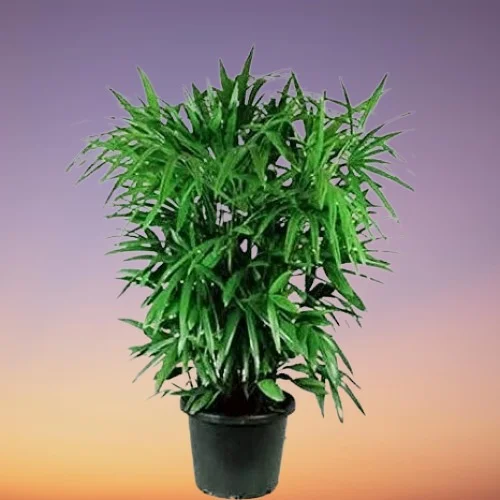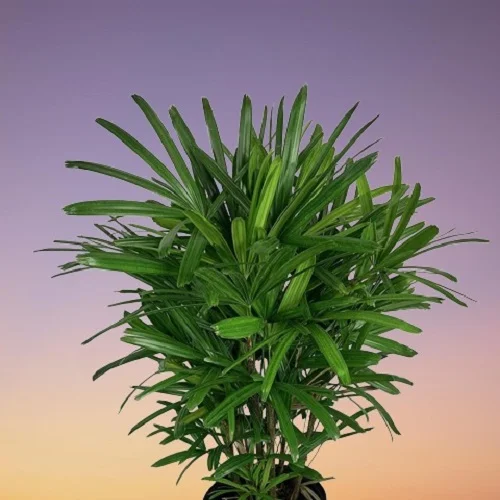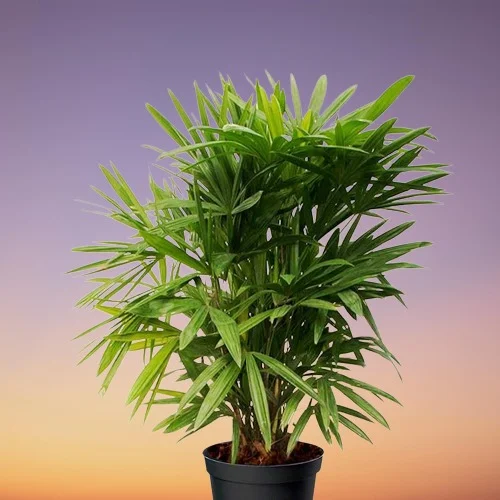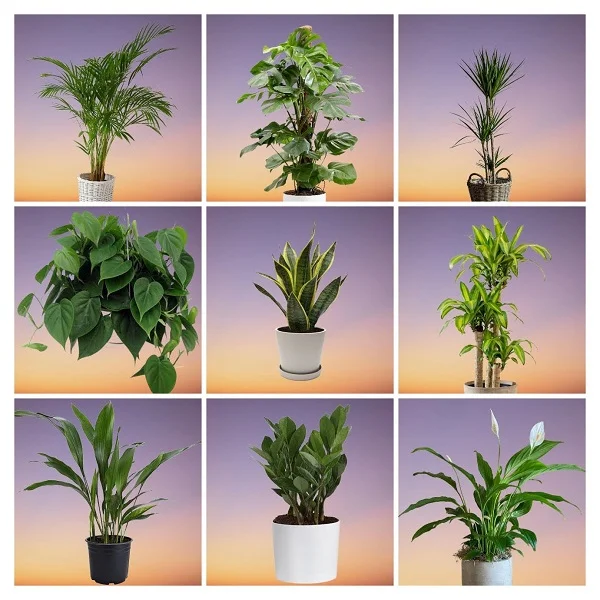Lady Palm (Rhapis excelsa) Indoor Care, Growing Problems with Solutions
Some links in this post may be affiliate links
Lady Palm (Rhapis excelsa) blossoms in bright to medium light, warm and moderately humid conditions and moderately moist, rich, well-drained soil coupled with monthly feeding in the growing season.
Rhapis excelsa is one of the popular palms and grows in multi-stemmed clumps with numerous, glossy, evergreen leaves divided into broad, ribbed segments.
Lady Palm belongs to the group of palms (called fan palms) which produce fronds which are split into numerous segments radiating from a point at the base (fan-like segments like ladies fan). The segments may be entirely or only partly divided.
The new foliage arises from a fibrous sheath which remains attached to the base. As it ages, the sheath falls, revealing bamboo-like trunks.
Lady Palm like Areca Palm (Dypsis lutescens), Fishtail Palm (Caryota mitis) and Pygmy Date Palm (Phoenix roebelenii) are attractive tropical foliage plants that will create a delightful spectacle in any space.

Botanical name: Rhapis excelsa
Family: Arecaceae
Common name: Lady Palm
Origin
Rhapis excelsa is native to tropical and sub-tropical India and Asia. It was first culltivated in China. The Japanese collected Lady Palm for their palaces in the 1600s, then the popularity spread to Europe and later to America and the rest of the world.
Size
Lady Palm grows to a height of upto 6 feet indoors. The leaf stalks are long, up to 2 feet or more and are generally toothed.
Air Cleaning
According to the NASA Clean Air Study, Rhapis excelsa was found to be a good indoor air cleaner in removing xylene, toulene, benzene, formaldehyde, trichloethylene and ammonia.
Toxicity
Rhapis excelsa is non-toxic to both humans and pets as indicated by ASPCA. It is safe to grow indoors.
Where to Buy
If you are looking to own the magnificent Lady Palm, you may get them online from Etsy (Link to Etsy).
Rhapis excelsa Care Indoors
Lady Palm (Rhapis excelsa) flourishes in bright to medium light, average warmth of 16-270C, humidity of 50-55% and moderately moist, fertile, well-drained, all purpose soil coupled with monthly feeding during the growing season.
Rhapis excelsa requires regular pruning to keep it neat as well as discourage pest and disease infestations. Repotting is needed every 3 years when it has outgrown its current pot. Keep on reading for more on these growing conditions and how to achieve them.

Light Requirements
Lady Palm grows best in bright to medium indirect light. Keep it away from direct sunlight as it may scorch the leaves.
Rotate the pot regularly to ensure that the palm receives light on all sides for uniform growth as well as prevent lopsided growth.
Watering
Water Lady Palm thoroughly while allowing the top 2-3 inches of soil to dry out between waterings to keep the soil moderately moist at all times during the growing season.
Cut down on watering during the cold season to maintain the soil slightly moist but do not allow the soil to dry out completely.
Use only chlorine-free water; like all palms, Rhapis excelsa is sensitive to chlorine and other chemicals dissolved in water.
Avoid getting the base wet as it can lead to rotting and eventual death of the palm. Do not allow the palm to sit in soggy soil as it may lead to root-rot and eventual loss of the palm.
Temperature and Humidity
Lady Palm requires an average warmth of 16-270C to thrive. If the temperature is comfortable for you it is ideal for this palm. Keep it away from cold drafts to avoid sudden drops in temperature as they may cause reduced growth.
Lady Palm has no need for extra humidity. Moderate room humidity of 50-55% is ideal for the palm. However, where the temperatures are very high, set the pot on a wet pebble tray or use a cool mist humidifier to raise humidity.
Occasionally clean the leaves by splashing water from a hose pipe to get rid of dust and also discourage pest infestations.
Fertilizer
Feed Lady Palm with a balanced, liquid fertilizer monthly during the growing period for a lush growth. Do not feed in the cold season as growth is minimal at this time.
Take care not to overfeed as it can lead to yellowing of the leaves. To prevent fertilizer build up which is indicated by leaf burn and brown spots, regularly flush the soil. Run a stream of water through the soil until water comes out through the drainage hole. Allow the stream of water to run for some time and repeat the process several times.
Potting Soil
The best soil for Lady Palm should be rich in organic matter and free-draining to prevent it from getting soggy while providing the required nutrients. Most all purpose potting mixes are ideal for this palm.
Repotting
Repot Lady Palm every 3 years when it has overgrown its current pot. Keep it crowded to prevent it from growing too fast. Use a pot one size larger than the current one. Make sure that the pot has a drainage hole to avoid getting soggy soil as it can lead to root-rot.
Apply a slow release fertilizer to the potting soil to promote faster establishment. The fertilizer will be adequate for the next 3-4 months.
Take care not to damage the roots and don't try to seperate or spread out the roots. Water the palm thoroughly and gently press down the soil to get rid of air pockets.
Pruning
Pruning Lady Palm is easy. Cut away the old brown and dry fronds near the soil surface to maintain the palm neat as well as discourage pest and disease infestations.
Where the seeds are required for propagation, allow the fruits to mature and drop then cut away the spent flower stalk. If the seeds are not required, cut away the flower stalk immediately it begins to form to prevent the palm from wasting energy on developing the flowers and seeds.
Propagation
Lady Palm (Rhapis excelsa) can be propagated from offshoots, by division or from seeds.
Read more on how to Propagate Lady Palm (Rhapis excelsa Propagation)

Rhapis excelsa Common Problems
Lady Palm (Rhapis excelsa) growing problems are brown leaf tips, yellowing, browning, leaf spots, pests and diseases among others. Keep reading for more on these problems, their remedies and solutions.
Browning leaves
Lady Palm browning leaves is due to age. The lower leaves may turn brown and droop at it ages; remove by cutting and not pulling.
If the browning of the leaves is general and accompanied by rotting, the reason is root-rot due to soggy soil. Make sure that the soil is free-draining and that the pot has a drainage hole to prevent the soil from getting soggy. Cut down on watering in the cold season to maintain the soil barely moist but do not allow the soil to dry out completely.
Pests
Common pests in Lady Palm are spider mites, scale insects and mealy bugs. Regularly check underneath the leaves of the palm for these pests. Isolate the affected palm to prevent spread to the other houseplants and treat it for these pests. Learn how to identify and get rid of pests in houseplants.
Brown leaf spots
Lady Palm brown leaf spots are due to two possible causes. Remove the affected leaves and discard, carry out corrective measures. One cause is overwatering. Water thoroughly and keep the soil moderately moist at all times during the growing season but not soggy.
Reduce watering during the cold season to maintain the soil slightly moist but do not allow the soil to dry out completely. Ensure that the pot has a drainage hole and that the soil is well-drained to avoid getting soggy soil. Learn more on how to water houseplants correctly.
The second causes of brown leaf spots in Rhapis excelsa is sudden decrease of temperature due to cold drafts. Keep it away from drafts to maintain an average warmth of 16-270C as it cannot tolerate cold temperatures. Check out this guide on understanding temperature for houseplants.
Brown leaf tips
Lady Palm brown leaf tips are due to four possible reasons. Trim off the brown tips with sterilized scissors. One reason for brown leaf tips is dry air (too little humidity). To raise humidity, set the pot on a wet pebble tray or use a cool mist humidifier. Read more on how to raise humidity for houseplants.
The second reason for Lady Palm brown leaf tips is underwatering. Water the palm liberally and keep the soil moderately moist at all times during the growing season. Lessen watering during the cold season to keep the soil slightly moist but never allow the soil to dry out completely.
The third reason for Rhapis excelsa brown leaf tips is cold drafts. Protect it from drafts to maintain an average warmth of 16-270C as it cannot tolerate cold temperatures.
The fourth reason for Lady Palm brown leaf tips is damage by touching. Place the palm away from the line of traffic to avoid brushing against it.
Yellowing leaves
Lady Palm yellowing leaves are caused by two possible reasons. One possible reason for yellowing leaves is watering issues; either underwatering or overwatering.
Water the palm thoroughly and keep the soil moderately moist at all times during the growing season. Reduce watering during the cold season but do not allow the soil to dry out completely.
The second reason for yellowing leaves in Lady Palm is overfeeding. Feed it with a balanced, liquid fertilizer monthly during the growing period and stop feeding it during the cold season as growth is minimal at this time. Learn how to feed houseplants.
You liked it? Share on social media.
Related Content
Amazon Associates Disclosure
Homeplantsguide.com is a participant in the Amazon Services LLC Associates Program, an affiliate advertising program designed to provide a means for sites to earn advertising fees by advertising and linking to amazon.com.





